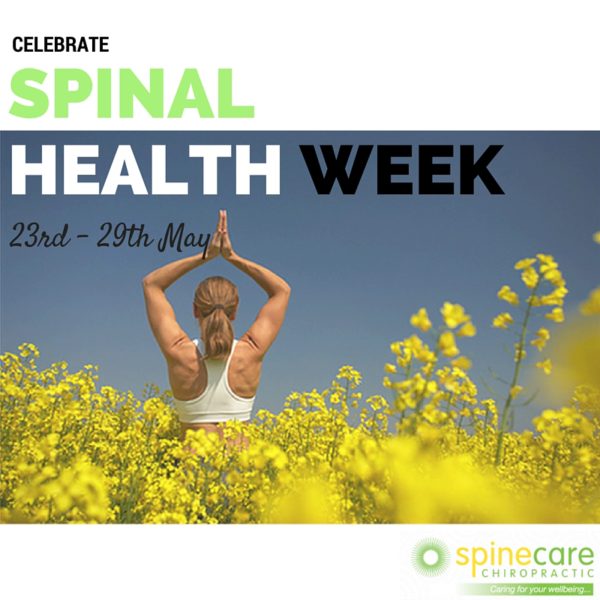Back your back with 12 top tips for spinal health.

To celebrate Spinal Health Week, we’ve compiled 12 of our favourite tips for spinal health from the office to the pillow.
These easy techniques will protect your spine and improve your life. (Go on, see how many you can fit into one day!)
Why care about the spine?
So glad you asked!
Your spine houses a large part of your nervous system (along with the brain) – the master control center of you. The nervous system (and by extension, the spine) is involved in every bodily function and directly influences your daily experience.
You can’t live without a nervous system, and your nervous system can’t function without a healthy spine.
As little as the weight of a 5 cent piece on part of your spine can reduce your nervous system function by up to 60%. It’s an intricate & delicate system, designed to be free from interference.
Unfortunately, modern life places it under huge amounts of stress.
We sit, slouch, twist, stay sedentary, hunch over phones and subject it to environmental, nutritional and emotional strain, daily.=
What can you do about it?
Besides regular adjustments, try these seriously healthy spinal habits to feel an immediate difference.
1.Be a posture ninja
Get vigilant, catch yourself in the act of slouching and commit to straightening up. We’ve written all about the benefits of good posture before, but it’s worth repeating. Maintaining good posture is the #1 thing you can do to protect your spine, moment to moment.
Here’s an easy way to think about it: keep your ear, shoulder and hip lined up neatly.
2. Keep movin’ movin’ movin’
According to the World Health Organisation (WHO), ‘Approximately 3.2 million deaths each year are attributable to insufficient physical activity’ (source)
Human bodies need to move; there’s no denying it.
But it’s not just a matter of life and death – your spine also suffers due to lack of activity.
Regular movement – daily walking, safe, enjoyable sports, strength and flexibility – keeps you limber. It decreases inflammation, supports healthy lymphatic flow and function, keeps muscles and ligaments strong and the spine supported plus reduces pain and stiffness.
Need help to get moving? Chat to us next time you’re in clinic. We can help you put one foot in front of the other in a way that works for you.
3. Mind that text neck!
What’s text neck, you ask? It’s this:
Looking down at your mobile phone or device and putting the weight of a bowling ball on your upper spine. This leads to pain, stiffness and ultimately – damage.
Our advice? Bring your device up to eye level, draw your chin back and take regular breaks from those ubiquitous screens.
4. Bags not.
Use a handbag? Carry a briefcase? Kids lugging big, heavy backpacks to school? Take a moment to investigate. Are these lopsided and cumbersome bags causing problems? Unsupportive bags + one-sided weight + heavy contents = sad spine! Ask us in clinic for advice and back-friendly recommendations.
5. Dream of good posture.
How do you sleep?
Chiropractors generally recommend sleeping on your back or side as opposed to your stomach.
It’s also a good idea to invest in a quality mattress – firm but supportive – and for perfect spinal/pelvic alignment you can also pop a pillow between your knees overnight.
6. Ditch the ciggies.
By now, we’re collectively well-versed in the dangers of smoking.
The same rules apply for the spine. Smoking promotes inflammation, dehydration, free-radical damage, depletes vitamins, minerals and oxygen to the tissues.
Ask us for advice and resources to help you quit. We’re your loudest cheerleaders!
7. Whole body wellness isn’t just for hippies.
Besides the obvious: sitting up straight, standing tall, not lifting and twisting, nutrition also plays a vital role in spinal health.
A wholesome diet high in fresh, seasonal, colourful produce and low in inflammatory fast food, bad fats and refined sugar will support your entire body – back included.
The right foods nourish and heal; decreasing inflammation, pain and the risk of disease.
What does this look like? There are no strict rules, but you can’t go wrong with oodles of veggies and fruit, non-processed meats and seafood (if you eat it), whole dairy (if you’re not allergic), nuts, seeds and a slice of soul food thrown in occasionally.
If it comes in a packet, leave it on the shelf.
8. Be brave, be gentle.
This tip is for anyone already suffering pain, injury or loss of function.
When you’re in chronic pain, sometimes you become fearful of any movement at all. However, there’s a point at which you need to be a little brave, a touch proactive and a lot gentle.
With the help of your Chiropractic practitioner, you can start incorporating beneficial movement that won’t hinder your progress – in fact, it’ll set you on the road to recovery.
9. Get creative in your cubicle
Did you know that Australian office workers spend up to 70% of their day sitting? That’s a whole lotta hours folded up, inactive.
To prevent the risks associated with being sedentary, it’s time to think outside the box (or, cubicle).
→ make sure management has invested time (and money) in ergonomic furniture
→ for every 30 minutes spent sitting, get up and move around for 1-2
→ maintain good seated posture
→ consider a standing desk (but make sure you ask us for advice, first! There’s a right and wrong way to go about it).
→ try ‘walking meetings’ instead of seated chats in the boardroom
10. Make like an apple and core.
And by that we mean: build a strong one.
Research shows that decreased core-stability muscle endurance is predictive of low back pain (source).
Work with a qualified personal trainer or ask us for specific exercises that will help strengthen and set that rock-solid middle.
11. Say hello to your spine.
Then ask: how are you?
By listening to what your spine’s trying to tell you, you can learn a lot about it’s health and function. If any movement or exercise causes you pain, it’s best to stop (and book in for a check-up).
Basic but effective advice.
12. Pay it forward.
The best way to nurture the next generation of spines? Educate your kids.
The habits we cultivate as children stick with us for life: encourage your little ones to stay healthy, active and properly aligned.


